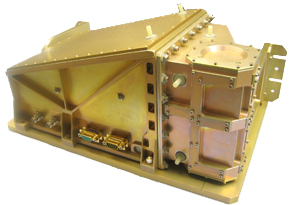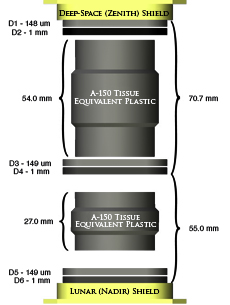CRaTER Instrument Overview
 |
|---|
| CRaTER flight model, above. (Rollover the image to view labels.) |
The hardware consists of a single, integrated sensor and electronics box with simple electronic and mechanical interfaces to the spacecraft. The sensor frontend design is based on standard stacked-detector cosmic ray telescope systems that have flown for decades, using detectors similar to those developed for other NASA flight programs.
The analog electronics design is virtually identical to that of the robust and flight-proven NASA/POLAR Imaging Proton Spectrometer that operated flawlessly in orbit for over a decade. The digital processing unit is also based on similar instruments with excellent spaceflight heritage.
 |
|---|
| Schematic of the instrument layout |
CRaTER consists of six silicon detectors in thin/thick pairs separated by sections of Tissue Equivalent Plastic (TEP). The Tissue Equivalent Plastic (such as A-150 manufactured by Standard Imaging) simulates soft body tissue (muscle) and has been used for both ground-based as well as space-based (i.e. Space Station) experiments.
The thin detectors (140 μm) are optimized for high energy deposits and the thick detectors (1000 μm) are optimized for low energy deposits, in particular, for protons. In nominal operating mode, an event is triggered when the energy deposit in any single detector rises above its threshold energy. A measurement is then made of the energy deposit in all six detectors. Directional information can be inferred for events that deposit energy into more than one detector (detection coincidences). Endcaps shield the detectors from protons with less than ~13MeV. Extra mass placed around the edges of the detectors provides additional shielding from some particles which may be able to penetrate through the sides of the instrument.
The table below shows the opening angle and geometric factor for the three relevant detector coincidences and the energy that a proton must have to penetrate that far into the instrument.
Property |
Value |
Comments |
|---|---|---|
Mass |
5.53kg |
6.36 kg allocation |
Power |
6.66W |
9.00 W allocation |
Maximum telemetry rate |
89.1 Kbps |
Sized for largest historic solar proton event |
Maximum event transmission rate |
1200 events/sec |
Event defined as pulse height analysis on all 6 detectors for any valid detection |
Low LET range |
0.09 keV/μm to 85 keV/μm |
Determined with thick detectors (D2, D4, D6) |
High LET range |
2.3 keV/μm to 2.2 keV/μm |
Determined with thin detectors (D1, D3, D5) |
LET resolution |
<0.3% of maximum LET in each range |
Net RSS value including detector and elctronics noise, and gain uncertainty |
Minimum geometric factor |
0.57cm2sr |
Defined by D1-D6 geometry |
Zenith full angle field of view |
31.4° |
Defined by D1-D6 geometry |
Nadir full angle field of view |
65.9° |
Defined by D4-D6 geometry |

